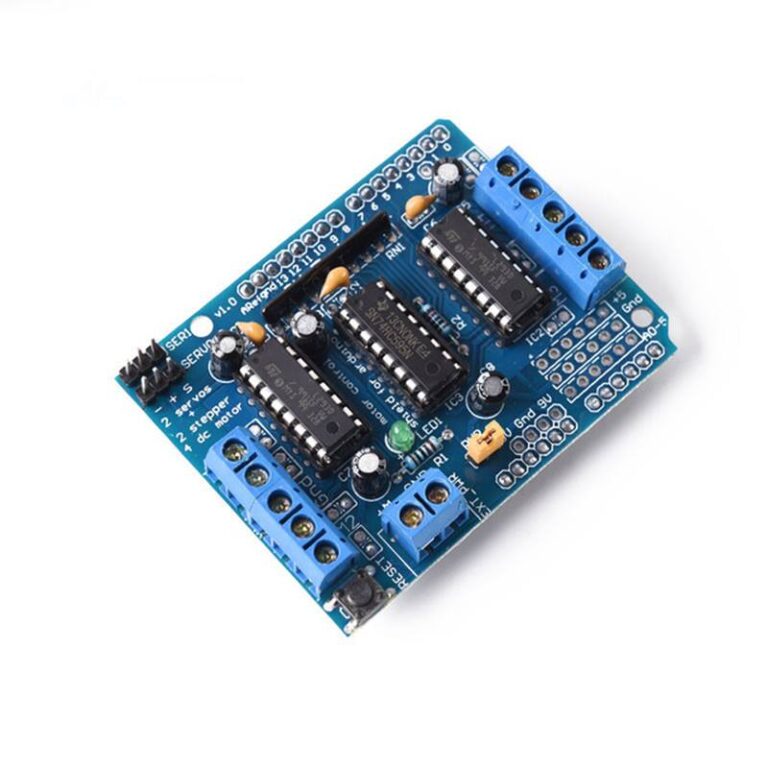

- Arduino stepper motor control board how to#
- Arduino stepper motor control board drivers#
- Arduino stepper motor control board driver#
Arduino stepper motor control board driver#
Right above these pins, we have the Sleep and the Reset pins which are used for, as their names suggest, putting the driver to sleep mode or resetting it. With each pulse we send to the Step pin, the motor will advance one step in the selected direction. With the Direction pin we select the rotation direction of the motor, and with the Step pin we control to steps of the motor. On the other side we have the Step and the Direction pins, which can be connected to any pin of the Arduino board. Next, we have the IC or the logic power supply pins, VDD and GND, which can be from 3V to 5V. Once we find a phase, we can connect it to any position of the two positions on the driver, the order doesn’t matter. If you connect two wires that make a phase, the rotation of the shaft would be a bit more difficult. The simplest way is to rotate the shaft of the stepper motor by hand, and then connect two wires to each other. Sometimes, it can be a bit difficult to recognize which two wires of the motor make a phase, but are several ways to identify them. One phase of the motor goes on 1A and 1B pins, and the other phase on 2A and 2B pins. Next, are the four pins where we connect the stepper motor. We should use large electrolytic capacitor with at least 47uF capacity. Here it is also recommended to use a decoupling capacitor across these two pins in order to protect the board from voltage spikes. As an Amazon Associate I earn from qualifying purchases.Īt top right corner of the driver we have the VMOT and GND pins and here we connect the power supply for the motor which can range 8 to 36V. Arduino Uno……………………………….… Amazon / Banggood / AliExpressĭisclosure: These are affiliate links.TMC2208 Stepper Driver ………………… Amazon / Banggood / AliExpress.DRV8825 Stepper Driver……….…….… Amazon / Banggood / AliExpress.

Arduino stepper motor control board how to#
A4988 and Arduino ConnectionĪll right, so now let’s see how to connect the A4988 driver with the stepper motor and the Arduino controller. Of course, it’s always recommended to try to match the current rating of the motor with the current rating of the driver. On the other hand, if the motor is rated lower than the set current limit on the driver, the motor would overheat. So, although the motor won’t work at its maximum capacity, we would still be able to use it. For example, we can connect even a 2.5A rated stepper motor, but we will limit the current of the driver to 1.5A. With this we can easily set how much current the motor will draw no matter the motor rating. It is recommended to keep the current to around 1A, but of course, it is also possible to go up to 2A of good cooling is provided to the IC.Ī great feature the A4988 stepper driver has, actually all other drives have, is the current limiting. The A4988 has a maximum current rating of 2A per coil, but that’s actually a peak rating.

You can watch the following video or read the written tutorial below which also includes all example codes and wiring diagrams. So, we got quite a lot to cover in this tutorial.

Also, I will show you how we can easily control multiple stepper motors using an Arduino CNC shield for any type of Arduino project.
Arduino stepper motor control board drivers#
I will explain in details how they work, how to connect stepper motors with Arduino, how to set the current limit of the drivers and how to program them with or without an Arduino library. I have already used it myself in many of my Arduino projects, like the following: This combination of stepper motors and drivers is used in countless applications where position control is needed, such as 3D Printers, CNC Machines, Robotics, Automation machines and so on. We will cover how to control a NEMA17 stepper motor in combination with a A4988, a DRV8825 and a TMC2208 stepper driver. In this tutorial we will learn everything we need to know about controlling stepper motors with Arduino.


 0 kommentar(er)
0 kommentar(er)
